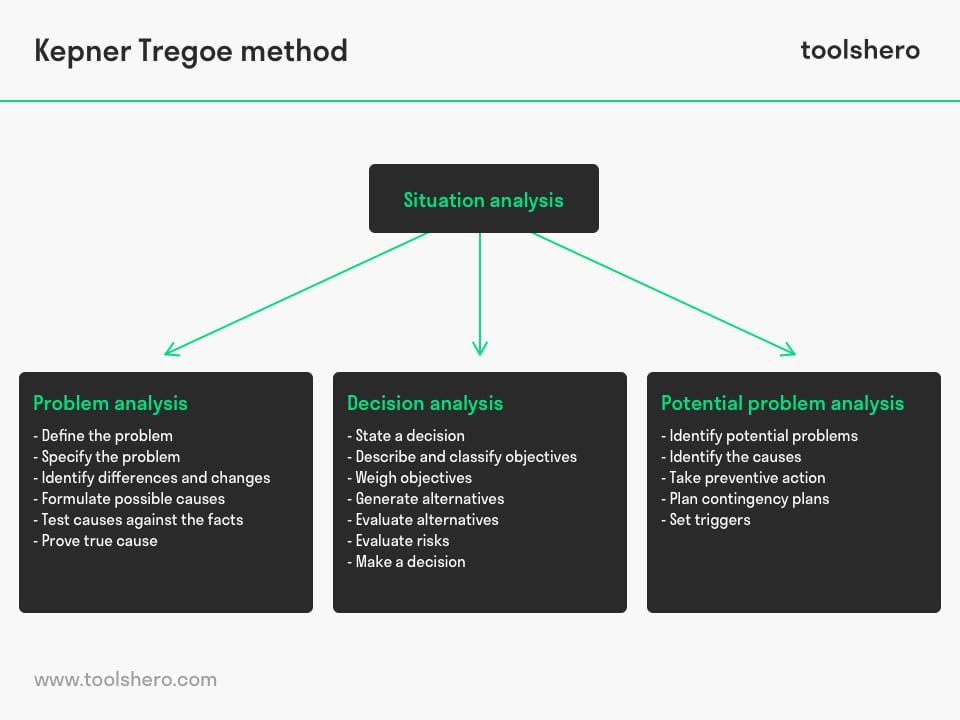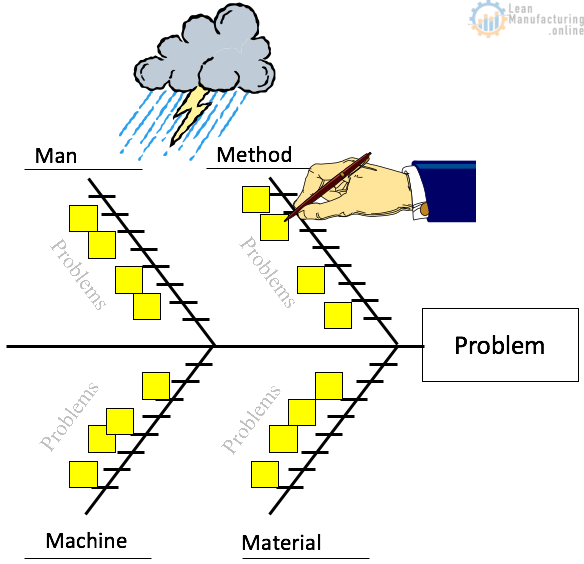- Memberships

Kepner Tregoe Method of Problem Solving

Kepner Tregoe Method of Problem Solving: this article explains the Kepner Tregoe Method , also known as the KT-method , developed by Charles Kepner and Benjamin Tregoe in a practical way. Next to what this is, this article also highlights rational processes, the importance of cause and that this method is effective. After reading, you’ll have a basic understanding of this problem solving process. Enjoy reading!
What is the Kepner Tregoe Method?
Problems occur in any given organization. Often there is pressure of time to solve the problems and it is debatable what the right way of solving these problems is.
The Kepner Tregoe method or KT-method is a problem analysis model in which the “problem” is disconnected from the “decision” . An English synonym for this problem solving method is Problem Solving and Decision Making (PSDM).

Traditional thinking pattern
The founders Charles Kepner and Benjamin Tregoe developed a rational working method in the 1960s in which they researched and identified the troubleshooting skills of people.
Throughout the centuries mankind has learned to deal with complexity and to (directly) anticipate on this. As a consequence, the traditional thinking pattern became a part of human nature.
When solving problems people search for the answer to the following four questions:
- What happened?
- Why did it happen?
- How should we act?
- What will be the (future) result?
Kepner Tregoe method: rational processes
To break through this traditional pattern Charles Kepner and Benjamin Tregoe came up with four rational processes in which four fundamental questions are reflected:
1. Situation analysis
This clarifies the problem situation (what happened).
1.1 Problem analysis
Here the actual cause of the problem and the relationship between cause and result are searched for (why did it happen).
1.2 Decision analysis
Based on the decision making criteria, choices are made to arrive at potential problem resolutions (how should we act).
1.3 Potential Problem analysis

Figure 1 – Kepner Tregoe Method Analysis
Distinction
According to the KT-method, different tasks involve different problems, which in turn need different approaches. A situation analysis will clarify the distinctions in all these processes and as a result it will be possible to search for suitable solutions. This situation analysis provides an insight into necessity, priority and urgency of the various tasks.
When it has become clear which tasks are to be prioritized (action list) preparations can be made for potential problems. By using a good problem analysis in advance, a process will be created to prevent future problems or in emergencies, to limit the damage.
The strengths of this method does not stop there. Apart from the fact that problems are specified in terms such as “what, where, when and how big”, the Kepner Tregoe Method focuses on anything that cannot be the cause of the problem.
Certain causes are therefore excluded. Based on a “this is” and “this is not” analysis a clear overview of possible causes can be created and this makes the troubleshooting process consistent.
The Kepner Tregoe Method is efficient
The KT-method deploys an efficient troubleshooting process. Through research Charles Kepner and Benjamin Tregoe discovered that the registration of a problem is not a uniform process. In spite of the available information, people usually process information badly, misinterpret this or overlook important matters.
In addition, Charles Kepner and Benjamin Tregoe examined the discrepancies between successful and less successful troubleshooting.
They discovered that a predetermined logical method facilitates the search for the causes of a problem. In their “Best practice in troubleshooting” , they describe this methodology, which forms the basis for this method.
The Kepner Tregoe Method is Effective
This method is universal and is still used today in many organizations to track down problems and identify potential causes. Apart from the fact that the Kepner Tregoe Method leads to an explanation of problems, it also helps improve mutual understanding within an organization.

It’s Your Turn
What do you think? Is the Kepner Tregoe Method applicable in today’s modern organizations? Do you recognize the practical explanation or do you have more suggestions? What are your success factors for the good Kepner Tregoe Method set up?
Share your experience and knowledge in the comments box below.
More information
- Lussier, R. N. (2005). Management fundamentals: concepts. applications, skill development . Cengage Learning .
- Payne, S. L. & Marty, C.S. (1966). The Rational Manager: A Systematic Approach to Problem Solving and Decision Making . Journal of Marketing. Vol. 30 Issue 1, p97.
- Kepner, C. H. & Tregoe, B. B. (1965). The Rational Manager . McGraw-Hill.
How to cite this article: Mulder, P. (2012). Kepner Tregoe Method . Retrieved [insert date] from Toolshero: https://www.toolshero.com/problem-solving/kepner-tregoe-method/
Original publication date: 06/30/2012 | Last update: 12/09/2023
Add a link to this page on your website: <a href=”https://www.toolshero.com/problem-solving/kepner-tregoe-method/”>Toolshero: Kepner Tregoe Method</a>
Did you find this article interesting?
Your rating is more than welcome or share this article via Social media!
Average rating 3.7 / 5. Vote count: 30
No votes so far! Be the first to rate this post.
We are sorry that this post was not useful for you!
Let us improve this post!
Tell us how we can improve this post?

Patty Mulder
Patty Mulder is an Dutch expert on Management Skills, Personal Effectiveness and Business Communication. She is also a Content writer, Business Coach and Company Trainer and lives in the Netherlands (Europe). Note: all her articles are written in Dutch and we translated her articles to English!
Related ARTICLES

Soft Systems Methodology (SSM) by Peter Checkland

Convergent Thinking: the Definition and Theory

CATWOE Analysis: theory and example

Means End Analysis: the basics and example

Systems Thinking: Theory and Definition

5 Whys Root Cause Analysis (Toyoda)
Also interesting.

Crowdsourcing: the meaning, definition and some examples

Systematic Inventive Thinking (SIT)

Linear Thinking by Edward De Bono explained
4 responses to “kepner tregoe method of problem solving”.
I am stunned to read that the Kepner Tregoe Method “…… IS STILL used today in many organizations to track down problems and identify potential causes…..”. I have used it all the time along my career as a manager of organizations, with extreme success. As a tool for identifying problems, as a tool for taking better decisions. So, please, I would appreciate to know what kind of system is being used now instead of an approach like K-T, to have provoked your comment about the existence of an alternative way of thinking.
Other than KT, I also use the Analytic Hierarchy Process (AHP) Like KT, it forces discipline and analysis and it helps to explain why decisions are made with understandable background and data. Many of the old Total Quality Management tools are also useful for solving problems and making good management decisions. Nominal Group Technique, Pareto Charts, and weighted multivoting are all quite useful. ITIL is the new way of thinking, but it can be rather dry and robotic unless it is underpinned with good decision tools.
Thank you for your comment and sharing your experience Pete.
Seems that I naturally deal with problems this way without knowing a name for it. In fact, it seems obvious to me that this approach should be taken anyway.
Leave a Reply Cancel reply
You must be logged in to post a comment.
BOOST YOUR SKILLS
Toolshero supports people worldwide ( 10+ million visitors from 100+ countries ) to empower themselves through an easily accessible and high-quality learning platform for personal and professional development.
By making access to scientific knowledge simple and affordable, self-development becomes attainable for everyone, including you! Join our learning platform and boost your skills with Toolshero.

POPULAR TOPICS
- Change Management
- Marketing Theories
- Problem Solving Theories
- Psychology Theories
ABOUT TOOLSHERO
- Free Toolshero e-book
- Memberships & Pricing

How it works
For Business
Join Mind Tools
Article • 8 min read
The Kepner-Tregoe Matrix
Making unbiased, risk-assessed decisions.
By the Mind Tools Content Team

No matter what position you hold, from the board room to the mailroom, you make decisions every day.
And the end result in business is directly linked to the quality of the decisions made at each point along the way.
So, not surprisingly, decision-making is a universally important competence in business. Some decisions clearly have a greater impact on the business than others, but the underlying skill is the same: the difference is in the scope and depth of the process you go through to reach your decision.
One reason why decision-making can be so problematic is that the most critical decisions tend to have to be made in the least amount of time. You feel pressured and anxious. The time pressure means taking shortcuts, jumping to conclusions, or relying heavily on instinct to guide your way.
Kepner-Tregoe: Taking the Guesswork out of Decision-Making
In your organization, you've probably heard of someone who made it all the way to VP by relying on his gut to make decisions. At the other extreme is the guy who simply can't make a decision because he analyzes the situation to death. The bottom line is, you have to make decisions, and you have to make good decisions. Poor decisions are bad for business. Worse still, one poor decision can lead to others, and so the impact can be compounded and lead to more and more problems down the line.
Thankfully, decision-making is a skill set that can be learned and improved on. Somewhere between instinct and over-analysis is a logical and practical approach to decision-making that doesn't require endless investigation, but helps you weigh up the options and impacts.
One such approach is called the Kepner-Tregoe Matrix. It provides an efficient, systematic framework for gathering, organizing and evaluating decision-making information. The approach was developed by Charles H. Kepner and Benjamin B. Tregoe in the 1960s and they first wrote about it in the business classic, The Rational Manager (1965). The approach is well-respected and used by many of the world's top organizations including NASA and General Motors. [1]
The Kepner-Tregoe Approach
The Kepner-Tregoe approach is based on the premise that the end goal of any decision is to make the "best possible" choice. This is a critical distinction: the goal is not to make the perfect choice, or the choice that has no defects. So the decision maker must accept some risk. And an important feature of the Kepner-Tregoe Matrix is to help evaluate and mitigate the risks of your decision.
The Kepner-Tregoe Matrix approach guides you through the process of setting objectives, exploring and prioritizing alternatives, exploring the strengths and weaknesses of the top alternatives, and of choosing the final "best" alternative. It then prompts you to generate ways to control the potential problems that will crop up as a consequence of your decision.
This type of detailed problem and risk analysis helps you to make an unbiased decision. By skipping this analysis and relying on gut instinct, your evaluation will be influenced by your preconceived beliefs and prior experience – it's simply human nature. The structure of the Kepner-Tregoe approach limits these conscious and unconscious biases as much as possible.
The Kepner-Tregoe Matrix comprises four basic steps:
- Situation Appraisal – identify concerns and outline the priorities.
- Problem Analysis – describe the exact problem or issue by identifying and evaluating the causes.
- Decision Analysis – identify and evaluate alternatives by performing a risk analysis for each and then make a final decision.
- Potential Problem Analysis – evaluate the final decision for risk and identify the contingencies and preventive actions necessary to minimize that risk.
Going through each stage of this process will help you come to the "best possible choice", given your knowledge and understanding of the issues that bear on the decision.
How to Use the Tool
The Kepner-Tregoe Matrix is an in-depth approach that can be supported by detailed instruction and worksheets. As an overview of the approach, the following steps show the general principles of how the Kepner-Tregoe approach can apply to a decision-making situation:
1. Prepare a decision statement.
- This is a general overview of what the decision is expected to achieve (the key objective).
- The statement should discuss the action that is required and the result that is desired.
2. Establish strategic requirements ("Must Haves").
- What "musts" will the final decision provide, allow for, include, etc.? For example: we must have 10 percent cost saving, we must include four color choices, the rope must hold 200 lbs.
- These requirements are absolute – there is no compromise.
3. Establish operational objectives ("Want to Haves").
- What do you "want" the final decision to support?
- By identifying the wants you can rank the alternatives according to which ones satisfy the most, or most important, wants.
4. Identify the restraints (Limits).
- What are the things that will limit your ability to do exactly what you want/need?
- These are typically resource constraints like money, materials, and time.
5. Rank the operational objectives and assign relative weights.
- For each "want", assign a rating of 1 – 10 based on the degree of importance.
6. Generate a list of alternatives.
- Think of as many alternative courses of action as you can. Don't be too concerned that they all meet the "musts" and "wants" you just defined. You will rank these alternatives in the next step.
- Brainstorming is a good approach for generating your list of alternatives.
7. Assign a relative score for each alternative.
- First, eliminate any alternatives that do not meet the "musts" – these are not worth considering any further.
- For the first alternative, go through each objective (want) and rate how well the alternative satisfies it using a 1 – 10 scale.
- Multiply the weight of the objective by the satisfaction rating to come up with a weighted score for each objective.
- Add the weighted scores to determine the total weighted score.
- Repeat the process for each alternative.
8. From the total weighted score for each alternative, rank the top two or three alternatives.
- Remember to make sure that the alternatives you choose meet all the "must" criteria.
9. For the top alternatives, generate a list of potential problems (adverse effects) for each.
- Rank the potential problems for each alternative according to probability and significance.
- Obtain a total weighted score for the adverse effect (adversity rating).
10. Analyze the alternative ranking and the adversity rating and make a final decision.
11. decide on mitigating actions for the chosen alternative..
- Look at each of the adverse effects already identified and generate a list of proactive responses to reduce the probability of each.
- Continuously monitor these probabilities and take action as needed.
The Kepner-Tregoe Matrix is a well-respected and systematic approach for making decisions. The matrix process forces users to be well-organized and thorough.
By weighting and ranking both the benefits and risks, it helps you choose the very best alternatives.
Using the Kepner-Tregoe approach requires patience and a commitment: the payoff for the time invested is good, unbiased decision-making that makes good business sense.
[1] Kepner, C. and Tregoe, B. (1965). ' The Rational Manager .' McGraw-Hill Book Company.
Kepner-Tregoe is a trademark of Kepner-Tregoe, Inc. See www.kepner-tregoe.com .
You've accessed 1 of your 2 free resources.
Get unlimited access
Discover more content
An introduction to business continuity management.
An Introduction to Business Continuity Management and Why it is So Important
Book Insights
Disruptive Analytics: Charting Your Strategy for Next-Generation Business Analytics
Thomas W. Dinsmore
Add comment
Comments (0)
Be the first to comment!

Get 30% off your first year of Mind Tools
Great teams begin with empowered leaders. Our tools and resources offer the support to let you flourish into leadership. Join today!
Sign-up to our newsletter
Subscribing to the Mind Tools newsletter will keep you up-to-date with our latest updates and newest resources.
Subscribe now
Business Skills
Personal Development
Leadership and Management
Member Extras
Most Popular
Latest Updates

Decision-Making Mistakes and How to Avoid Them

Using Decision Trees
Mind Tools Store
About Mind Tools Content
Discover something new today
Better processes.
Tools and techniques to design business processes that deliver results
Essential Strategy
Discover a range of strategic planning tools to set your organization up for success
How Emotionally Intelligent Are You?
Boosting Your People Skills
Self-Assessment
What's Your Leadership Style?
Learn About the Strengths and Weaknesses of the Way You Like to Lead
Recommended for you
How to have a good day: think bigger, feel better and transform your working life.
Caroline Webb
Business Operations and Process Management
Strategy Tools
Customer Service
Business Ethics and Values
Handling Information and Data
Project Management
Knowledge Management
Self-Development and Goal Setting
Time Management
Presentation Skills
Learning Skills
Career Skills
Communication Skills
Negotiation, Persuasion and Influence
Working With Others
Difficult Conversations
Creativity Tools
Self-Management
Work-Life Balance
Stress Management and Wellbeing
Coaching and Mentoring
Change Management
Team Management
Managing Conflict
Delegation and Empowerment
Performance Management
Leadership Skills
Developing Your Team
Talent Management
Problem Solving
Decision Making
Member Podcast

Victor Leung

Understanding the Kepner-Tregoe Technique - A Guide to Enhanced Problem-Solving and Decision-Making

In the dynamic world of business, the ability to efficiently solve problems and make decisions is crucial for success. The Kepner-Tregoe technique, developed by Charles H. Kepner and Benjamin B. Tregoe, is a structured methodology that aids in the systematic analysis and resolution of problems. This blog post delves into the essence of the Kepner-Tregoe technique, exploring its key components and benefits.

What is the Kepner-Tregoe Technique?
The Kepner-Tregoe technique is a problem-solving and decision-making framework that provides a systematic approach for identifying, analyzing, and resolving issues. It consists of four main processes:
Problem Analysis : This process involves defining the problem, understanding its nature, and diagnosing the root cause. By distinguishing between what is known and unknown, the problem is clarified, making it easier to identify potential solutions.
Decision Analysis : This step is crucial for making informed decisions. It involves evaluating alternatives against a set of objectives and identifying the risks associated with each option. This helps in selecting the most feasible and beneficial solution.
Potential Problem (or Opportunity) Analysis : Here, the focus shifts to forecasting future issues or opportunities. This proactive approach helps in preparing for potential challenges and capitalizing on opportunities that may arise from the decision made.
Situation Appraisal : This involves assessing the situation to prioritize issues, plan the next steps, and allocate resources effectively. It helps in managing multiple problems or decisions simultaneously.
Benefits of the Kepner-Tregoe Technique
Enhanced Problem-Solving Skills : The technique fosters a deep understanding of the problem, leading to more effective solutions.
Improved Decision-Making : By systematically evaluating alternatives, the technique ensures that decisions are well-informed and aligned with objectives.
Risk Management : It helps in identifying potential risks and prepares organizations to mitigate them effectively.
Efficient Resource Allocation : By prioritizing issues, the technique ensures that resources are used optimally.
Fosters Team Collaboration : The structured approach encourages teamwork and clear communication, making it easier to reach a consensus.
Implementing the Kepner-Tregoe Technique
To effectively implement the Kepner-Tregoe technique, organizations should:
Train Employees : Provide training to develop the necessary skills for applying the technique.
Encourage a Systematic Approach : Foster a culture where problems are approached methodically, using the Kepner-Tregoe processes.
Utilize in Various Scenarios : Apply the technique across different types of problems and decisions to maximize its benefits.
Regularly Review and Refine : Continuously assess the effectiveness of the technique and make adjustments as needed.
The Kepner-Tregoe technique is a powerful tool for organizations seeking to enhance their problem-solving and decision-making capabilities. By providing a structured approach, it not only leads to better outcomes but also promotes a culture of strategic thinking and collaboration. Implementing this technique can be a game-changer for businesses aiming to navigate complexities with greater confidence and efficiency.
Ready for more?
Kepner-Tregoe Decision Analysis: A Comprehensive Overview

Decision-making plays a critical role in the success of any business, necessitating methodologies that can streamline and enhance the process. The Kepner-Tregoe Decision Analysis stands out as a time-tested and systematic technique designed to tackle complex business problems effectively. This article examines the intricate details, steps, and nuances of the Kepner-Tregoe method, assessing its advantages and possible limitations. With the dual aims of providing a comprehensive overview and practical guidance, this post will serve as an essential resource for professionals seeking to enhance their decision-making skills through problem solving training courses or an online certificate course .
🔊 Ready for an auditory reading experience? Just click the 'Play' button right below this text and immerse yourself in our captivating audio version. Ideal for those who prefer listening to stories, or for times when you're multitasking. Engage with our content effortlessly - one simple click is all it takes to transform your reading into listening!
What is Kepner-Tregoe Decision Analysis?
The Kepner-Tregoe Decision Analysis is a structured methodology facilitating a careful, step-by-step approach to decision-making. Created by Charles Kepner and Benjamin Tregoe in the 1960s, the method provides a framework for identifying, analyzing, and resolving problems. Its principles are deeply rooted in rationality and a systematic approach, guiding users to cut through complexity by focusing on logical analysis and factual data.
The logical sequence of the decision-making process is what sets the Kepner-Tregoe method apart from less structured approaches. It compels users to look beyond the symptoms of a problem and concentrate on distinguishing causes from effects. This segmentation helps in clarifying issues, setting priorities, and making more informed choices.
An illustrative example of Kepner-Tregoe Decision Analysis in real-world situations could involve a manufacturing company facing a decline in product quality. By employing this method, the company can systematically dissect the issue, analyze potential causes, and decide on the most effective course of action to maintain quality standards while minimizing disruptions to production.
Steps involved in the Kepner-Tregoe Decision Analysis
Stage one: situation analysis, definition and understanding the problem.
At this initial stage, decision makers must clearly define the problem at hand. This means distinguishing between actual problems and perceived problems—focusing on concrete issues rather than symptoms. The Kepner-Tregoe methodology emphasizes the importance of factual information in defining problems, thereby establishing a clear objective for the resolution process.
Prioritizing problems
Not every problem demands immediate attention, and the Kepner-Tregoe Decision Analysis acknowledges this by incorporating a prioritization framework. Decision makers are encouraged to rank problems based on the urgency and impact on the business, setting the stage for an efficient allocation of resources to areas where they are most needed.
Stage Two: Problem Analysis
Identifying root causes.
With the problems defined and prioritized, the next step is to drill down into the root causes. This in-depth analysis requires questioning and exploring all possible sources of the problem, often employing tools such as the 'five whys' technique to peel back layers and reveal underpinning issues.
Verifying root cause
Once potential causes are identified, they must be systematically verified against the evidence. It is crucial in the Kepner-Tregoe process to investigate each hypothesized cause and test it against existing data, reducing the risk of misdiagnosis and ensuring that the subsequent steps in the decision-making process are founded on an accurate understanding of the problem.
Stage Three: Decision Analysis
Evaluating alternatives.
Decision-makers analyze different courses of action by listing out needful objectives and comparing potential solutions accordingly. Kepner-Tregoe encourages a comprehensive evaluation where alternatives are weighted against the objectives, with the aim of pinpointing the most beneficial outcome.
Risks associated with each alternative
In the evaluation stage, risks are a key consideration in the Kepner-Tregoe methodology. Each potential solution comes with its set of risks, and it is crucial to understand and manage these risks before any decision is finalized.
Stage Four: Potential Problem Analysis
Implementing the decision.
Implementation involves not just enacting the chosen solution but also preparing for potential fallouts and monitoring the results. The Kepner-Tregoe Decision Analysis suggests having contingency plans in place which can be executed if things don't go as expected.

Reviewing and learning
Post-implementation review is an integral part of the decision-making cycle. This stage includes assessing the outcome against the objectives and learning from both successes and setbacks to improve future decision-making processes.
Example case elaborating on each stage
To further cement understanding, we might consider a technology company that has decided to integrate a new software system. Following the Kepner-Tregoe process, it would start by clearly defining the objectives of the integration, proceed to identify and solve potential issues that could arise, thoroughly evaluate all possible software systems and vendors, take into account risks and prepare mitigation strategies, and conclude with the implementation, monitoring, and review of the chosen solution.
Advantages and Limitations of Kepner-Tregoe Method
Discussion on the positives of this analytical approach.
The Kepner-Tregoe Decision Analysis shines with its disciplined, step-by-step approach that can reduce the subjectivity and bias often present in decision-making processes. It is lauded for fostering clarity, improving communication among stakeholders, and leading to more robust and defendable decisions.
Limitations and potential setbacks of Kepner-Tregoe Decision Analysis
However, this methodology is not without its drawbacks. The very rigor that defines the Kepner-Tregoe process can also render it somewhat inflexible. In situations where quick decisions are necessary, the method's structured nature might be seen as a hindrance. Additionally, it relies heavily on the accurate and comprehensive gathering of data, which in some scenarios may not be possible or practical.
Comparing the Kepner-Tregoe method with other decision-making tools
In comparison with other decision-making tools, such as SWOT analysis or the Delphi Technique, Kepner-Tregoe offers a more comprehensive framework that encompasses the entire decision-making cycle from problem identification to post-implementation review. It can be preferable in situations where the depth of analysis is crucial, though it might be considered too cumbersome for more straightforward decision scenarios.
Real-life examples demonstrating advantages and limitations
Real-life applications, like a healthcare provider balancing cost-efficiency with patient care or a financial institution evaluating investment opportunities, demonstrate the method’s utility in complex and data-rich environments, highlighting both its effectiveness in thorough decision-making and its potential limitations when time is of the essence.
Practical Tips for Implementing Kepner-Tregoe Decision Analysis
Best practices when utilizing kepner-tregoe decision analysis.
To effectively implement the Kepner-Tregoe Decision Analysis, organizations should invest in training staff to understand and apply the methodology correctly. Encouraging a culture of questioning and objective analysis can also aid in seamless integration of the process into business operations.
Misconceptions and common mistakes to avoid
It is essential to avoid common pitfalls such as rushing through stages, neglecting comprehensive data collection, or failing to involve key stakeholders. Each step in the Kepner-Tregoe process should be given due time and consideration to ensure that the underlying principles of systematic analysis are upheld.
Additional resources for mastering the process
To gain in-depth expertise, individuals may participate in problem solving training courses or pursue an online certificate course in Kepner-Tregoe Decision Analysis. Such resources can provide interactive learning experiences and case studies to solidify one's grasp of the method.
Conclusion: The Impact of sound Decision Analysis on Business Success
Summarization of key points covered.
This article has traversed the various aspects of Kepner-Tregoe Decision Analysis, elucidating its structured approach on how organizations can tackle complex problems and make sound decisions. We have delved into its systematic processes, revealed its benefits, and discussed its limitations.
The strategic influence of Kepner-Tregoe Decision Analysis on business growth and success
The strategic application of the Kepner-Tregoe method can significantly influence business growth and success. By facilitating better decision-making, it can lead to higher-quality outcomes, improved efficiency, and stronger competitive positioning.
Encouragement to adopt systematic decision-making processes in business for overall success
Businesses are encouraged to adopt systematic decision-making processes like Kepner-Tregoe to navigate the complex landscape of modern business challenges. Embracing such frameworks not only enhances the quality of decisions but also reinforces organizational learning and resilience.
What are the key steps involved in Kepner-Tregoe Decision Analysis and how do they contribute to effective problem-solving?
Understanding kepner-tregoe decision analysis.
Kepner-Tregoe Decision Analysis stands as a structured methodology. It helps individuals and organizations solve problems effectively. This methodology bases itself on a rational framework. It promotes thorough analysis and clear decision-making.
Key Steps in the Kepner-Tregoe Decision Analysis
The Kepner-Tregoe process breaks down into four critical steps. These contribute to an analytical approach to problem-solving.
Situation Appraisal
Identify concerns and outline priorities. Start with listing all the issues. Distinguish concerns from actual problems. Questions start the process. They focus on "what", "why", and "how" regarding the issues at hand. This step ensures a structured understanding of the situation.
Problem Analysis
Clarify the problem. Here, you examine the issue in depth. Start with identifying the problem's core. Next, describe the problem explicitly. Consider what the problem is and isn't. Observe when and where it occurs. Find out why the issue matters. This step seeks to limit the problem's scope.
Decision Analysis
Explore options and make decisions. Begin by delineating your objectives. Prioritize these objectives. Develop alternatives based on these priorities. Evaluate these by comparing them to your criteria. Make the decision with the best alignment to your goals. Here, you ensure selections are systematic and justifiable.
Potential Problem Analysis
Anticipate future issues and plan. Consider what could go wrong. Predict potential problems and prepare for them. Plan preventative actions. Establish contingency plans. This step aims to minimize future risks.
Each Step's Contribution to Problem-Solving
Kepner-Tregoe Decision Analysis contributes to effective problem solving in several ways:
- Clarifies complexity : By breaking down problems, it makes the complex manageable.
- Promotes data-driven decisions : The focus on evidence and criteria facilitates objective choices.
- Improves communication : Clear frameworks aid in articulating problems and solutions.
- Increases efficiency : Structured approaches save time and reduce uncertainty.
- Enhances risk management : Anticipating challenges enables proactive measures.
Kepner-Tregoe Decision Analysis stands as a powerful tool. It guides teams through the problem-solving maze. Its structured, step-wise approach fosters clarity, decision-making, and risk planning. Ultimately, it can drive effective solutions to complex business challenges.
How does Kepner-Tregoe Decision Analysis differ from other decision-making methodologies?
Kepner-tregoe decision analysis fundamentals.
Kepner-Tregoe Decision Analysis stands unique. It offers a systematic approach. Other methodologies vary in structure. They also differ in focus. Kepner-Tregoe emphasizes rational clarity. It prioritizes a step-by-step procedure. This process ensures thoroughness. Each step builds on the previous one. This yields comprehensive decision-making.
Emphasis on Problem Analysis and Evaluation
Kepner-Tregoe starts with problem analysis. It distinguishes itself with a particular focus. The focus lies on problem understanding. Clarity and definition matter here. These elements precede alternative evaluation. This contrasts with other methods. Many alternate techniques jump straight into solution generation. In Kepner-Tregoe, one cannot proceed without clear problem understanding.
Potential Problem and Opportunity Analysis
Risk management is integral to Kepner-Tregoe. It features potential problem analysis. This analysis identifies what could go wrong. It also includes potential opportunity analysis. This targets what could go right. Other methods often underplay these steps. They typically focus on problem-solving. Kepner-Tregoe balances problem-solving with preemptive assessment.
Structured Decision-Making Process
Kepner-Tregoe promotes a structured approach. It delineates explicit steps. Each step has defined objectives. The structure promotes disciplined thinking. It discourages cognitive biases. This is different from less structured methodologies. Many such methods allow more flexibility. But they risk unstructured decision-making.
Criteria Weighting and Decision Analysis
Decision criteria receive systematic weighting in Kepner-Tregoe. It uses a numerical scoring system. This compares options objectively. Other methods might use criteria. Yet, they often lack quantitative assessment. Kepner-Tregoe's use of weights adds precision. This enables clear, defensible choices.
Focus on Skill Development
Kepner-Tregoe emphasizes skill-building. It relies on trained facilitators. Facilitators guide participants through the process. This aims at skill transfer. Participants learn to apply the method independently. Other methodologies do not focus as much on skill development. They often rely on experts. These experts make the decisions without building organizational capacity.
Broad Application Spectrum
The versatility of Kepner-Tregoe stands out. It suits diverse problems. These can be technical or managerial. It supports individual or group decisions. Other methods might specialize. They could target specific domains or problem types. Kepner-Tregoe offers a comprehensive toolkit. This toolkit can adapt to a multitude of scenarios.
In summary, Kepner-Tregoe Decision Analysis provides a detailed, methodical approach. It enforces disciplined problem analysis. It anticipates risks and opportunities. The process is highly structured with quantitative criteria evaluation. It simultaneously fosters individual and organizational capability. These qualities distinguish Kepner-Tregoe from other decision-making methodologies. It excels in promoting clear, rational, and well-supported decisions.
What are the potential challenges or limitations of applying Kepner-Tregoe Decision Analysis in real-world scenarios?
Kepner-Tregoe Decision Analysis stands as a structured methodology. It aids in problem-solving and decision-making. Developed by Charles Kepner and Benjamin Tregoe, the method is systematic. It requires analysts to evaluate problems based on available data.
This process focuses on critical thinking. Analysts must address potential biases. They aim for rational decision-making. While this approach has merits, real-world application presents challenges.
Issues with Complex Data Interpretation
Data overload poses a significant problem. Analysts may face overwhelming information. This can lead to analysis paralysis. Critical decisions require timely analysis. Delayed conclusions can disrupt business operations.
Quality of data also impacts analysis. Poor data may lead to flawed decisions. Decisions rely on the strength of available information. Analysts must often make decisions with incomplete data sets.
Adhering to a Structured Process
The method demands strict adherence to steps. Teams may find this rigid. Innovation thrives in more flexible environments. Creativity can suffer under rigid frameworks. The process also assumes logical progression. Real-life problems can be chaotic and non-linear.
Skill and Experience Requirements
Successful application needs skilled practitioners. These individuals must have analytical competencies. They must understand complex decision-making frameworks. Training is essential for teams. Without training, employees may struggle.
Teams unfamiliar with the Kepner-Tregoe approach often face learning curves. Implementation becomes time-consuming. Adjustment periods can slow down processes initially.
Difficulty in Quantifying Qualitative Data
The method often quantifies factors for analysis. Not all criteria easily translate into numbers. Qualitative data quantification presents its challenges. Subjective inputs can skew results.
Objectivity is vital. Yet personal biases can influence decisions. Teams must remain vigilant against such challenges.
Resistance to Change
Change meets resistance in most organizations. Introducing new methodologies is no different. Employees may resist structured decision-making. They might prefer established, less formal methods. Buy-in is crucial from all levels.
Leaders must champion the Kepner-Tregoe process. They should work to overcome resistance. Employees need to see the value of this approach.
Cost and Resource Allocation
Implementing this methodology requires investment. Resources must be allocated for training. This includes both time and money. Small organizations may find this prohibitive. ROI calculations can deter adoption.
Limited Application in Certain Scenarios
Certain scenarios may not lend themselves to this method. Crisis situations require rapid responses. The structured approach suits less urgent problems better. Situations needing emotional intelligence can also pose problems.
Rigid analysis frameworks might not fit well. Human elements can be unpredictable. Kepner-Tregoe may not capture all nuances.
Kepner-Tregoe Decision Analysis is a robust tool. Yet, like any framework, it has limitations. Real-world scenarios bring complex challenges. Analysts must navigate these carefully. Tailoring the approach to fit specific needs often works best.
Understanding constraints allows for better preparation. Teams can address these limitations head-on. This preparation promotes a more successful application of Kepner-Tregoe.

He is a content producer who specializes in blog content. He has a master's degree in business administration and he lives in the Netherlands.

Plato: A Beacon of Influence Through Desire, Emotion, & Knowledge

Exploratory Data Analysis: Unraveling its Impact on Decision Making

Problem Framing: A Strategic Approach to Decision Making

Developing Problem Solving Skills Since 1960s WSEIAC Report
Using the Kepner-Tregoe Methodology for Effective Problem-Solving
The Kepner-Tregoe methodology is a problem-solving and decision-making framework that helps individuals and organizations systematically analyze problems, make decisions, and manage risks. Developed by Charles Kepner and Benjamin Tregoe in the 1950s, the methodology has been widely adopted by businesses, governments, and other organizations worldwide. One of the core components of the Kepner-Tregoe methodology is the use of a matrix to identify the root cause of a problem. In this article, we will explore how the matrix works and how it can be used to solve complex problems.
The Kepner-Tregoe methodology consists of four distinct steps: Situation Appraisal, Problem Analysis, Decision Analysis, and Potential Problem Analysis. Each step is designed to help individuals and teams approach complex problems in a structured and systematic way. In this article, we will focus on the Problem Analysis step, which involves identifying the root cause of a problem using a matrix.
The Problem Analysis step begins with defining the problem. This step involves clearly stating the problem and its impact on the organization. Next, the team identifies the symptoms of the problem. Symptoms are the visible or measurable indicators of the problem. Once the symptoms are identified, the team uses a matrix to identify the root cause of the problem.
The matrix used in the Kepner-Tregoe methodology is called the Cause and Effect Analysis matrix, also known as the Ishikawa or fishbone diagram. The matrix is a visual tool that helps individuals and teams identify the underlying causes of a problem. The matrix is structured like a fishbone, with the problem or effect at the head of the fishbone and the potential causes of the problem branching off like a fish’s bones.
To use the matrix, the team first identifies the problem or effect that needs to be analyzed. This is written at the head of the fishbone. Next, the team identifies the major categories of potential causes that may be contributing to the problem. These categories are written on the main branches of the fishbone. Examples of potential categories include people, processes, technology, and the environment.
Once the major categories are identified, the team begins to brainstorm the potential causes within each category. Each potential cause is written on a small branch of the fishbone. The team continues to brainstorm potential causes until all potential causes have been identified.
Once the potential causes have been identified, the team begins to analyze each cause to determine its likelihood of contributing to the problem. This analysis involves evaluating each potential cause based on its ability to explain the symptoms of the problem. The team also considers the likelihood that each potential cause is contributing to the problem and the potential impact of each cause on the organization.
Based on this analysis, the team can identify the root cause of the problem. The root cause is the underlying issue causing the problem’s symptoms. Once the root cause has been identified, the team can develop and implement a solution to address the problem.
In conclusion, the Kepner-Tregoe methodology is a powerful tool for problem-solving and decision-making. The Problem Analysis step, which uses the Cause and Effect Analysis matrix, is a critical methodology component. By using the matrix, teams can systematically identify the root cause of a problem and develop effective solutions. Whether you are an individual or a team member, the Kepner-Tregoe methodology can help you approach complex problems confidently and clearly.
References: Kepner, C. H., & Tregoe, B. B. (2013). The new rational manager. Princeton, NJ: Princeton Research Press. Wu, T. (2019). An overview of the Kepner-Tregoe problem-solving methodology. Journal of Applied Management and Entrepreneurship
- More By sensei
- More In Blog

Maximize Efficiency with the Right Plant Layout: A Comprehensive Guide

Harnessing Business Excellence in Manufacturing Through the PDCA Approach

The Fishbone Diagram

Unlock the Power of Continuous Learning with Udemy’s Frequent Sales

How to Ace Your Next Job Interview: Expert Insights and Strategies

Mastering the Trio: Project, Program & Portfolio Management

Behaviors that kill employee motivation

Common Interview Questions for Project Management Roles
Leave a reply cancel reply.
Your email address will not be published. Required fields are marked *
Most Popular

4M Analysis Process
The purpose of this procedure is to define the steps to do a 4M …

PDCA – A Process Approach

OPL – One Point Lesson Template – Free Download

5S Audit Checklist and Report

Why-Why Analysis
Blog Search

- Terms of Use
- Privacy Policy
- About Our Ads

An official website of the Department of Health & Human Services

- Search All AHRQ Sites
- Email Updates
Informing Improvement in Care Quality, Safety, and Efficiency
- Contact DHR
Kepner-Tregoe Matrix
A Kepner-Tregoe matrix is used to find causes of a problem. It isolates the who, what, when, where, and how aspects of an event, keeping the focus on the elements that have an impact on the event and eliminating the elements that do not. This allows you to compare what the problem is, with what it is not, illuminating distinctive features of the problem and pointing out its potential causes.
To clarify what the problem is not about.
When identifying the causes of quality problems.
When brainstorming.
1. DESCRIBE THE EVENT in a clear manner so it can be understood by everyone.
2. PRODUCE AN EMPTY MATRIX of six rows by four columns. Fill the headings of the 4 colums with the following: "performance shortcoming," "is," "is not," and "distinction." Below the top row, fill the row headings of the rows with the following: "what occurs, what objects are affected?," "where does the problem occur?", "when does the problem occur?", "extent of shortcomings?", and "who is involved?"
3. RECORD THE PROBLEM OR EVENT under analysis in the upper left-hand corner of the matrix.
4. DESCRIBE WHAT DID OR DOES OCCUR using the "is" column. Determine the objects affected and what specifically occurs. Determine the location of the event. Determine when the event occurs, whether it has recurred, whether it happens in conjunction with any other events, and any patterns observed.
5. DETERMINE THE EXTENT OF THE PROBLEM. Think about how many objects had problems and how many problems each object had. Determine the severity of the problems.
6. DETERMINE WHO is involved in the event. However, ensure that this step does not assign blame.
7. IDENTIFY CIRCUMSTANCES that could occur but do not recur using the "is not" column.
8. Examine the "is" and "is not" columns to IDENTIFY WHAT IS DIFFERENT OR UNUSUAL about events where the problem exists versus where it is absent ("is" versus "is not"). Record your observations in the "distinctions" column.
9. FOR EACH DISTINCTION DETERMINE whether it relates to a known change. Examine how the change could have caused the problem. Record all possible causes.
10. TEST ALL POSSIBLE CAUSES BY DETERMINING whether the each item in the "is" and "is not" columns can be explained by the cause. The most likely cause explains every aspect of the problem.
11. PLAN AN EXPERIMENT TO VERIFY THE CAUSE(S) identified, if possible.
Can be used at any stage of a process improvement effort.
Is a useful tool for problem discovery and resolution.
Offers exhaustive process for accurate problem definition.
Is time consuming.
Andersen B. Tools for analyzing the performance shortcoming. In: O'Mara P, editor. Business process improvement toolkit. 2nd ed. Milwaukee, WI: ASQ Quality Press; 2007. p. 123-55.
Tague N. The tools. In: O'Mara P, editor. The quality toolbox. 2nd ed. Milwaukee, WI: ASQ Quality Press; 2005. p. 93-521.
Lighter D. Process orientation in health care quality. In: Moore C, editor. Quality management in health care: principles and methods. 2nd ed. Sudbury, MA: Jones and Bartlett Publishers; 2004. p. 43-101.
- Director's Corner
- Current Priorities
- Executive Summary
- Research Spotlight
- Research Themes and Findings
- Research Dissemination
- Research Overview
- 2020 Year in Review
- 2019 Year in Review
- Engaging and Empowering Patients
- Optimizing Care Delivery for Clinicians
- Supporting Health Systems in Advancing Care Delivery
- Our Experts
- Search AHRQ-Funded Projects
- AHRQ-Funded Projects Map
- AHRQ Digital Healthcare Research Publications Database
- A Practical Guide for Implementing the Digital Healthcare Equity Framework
- ePROs in Clinical Care
- Guide to Integrate Patient-Generated Digital Health Data into Electronic Health Records in Ambulatory Care Settings
- Health IT Survey Compendium
- Time and Motion Studies Database
- Health Information Security and Privacy Collaboration Toolkit
- Implementation in Independent Pharmacies
- Implementation in Physician Offices
- Children's Electronic Health Record (EHR) Format
- Project Resources Archives
- Archived Tools & Resources
- National Webinars
- Funding Opportunities
- Digital Healthcare Research Home
- 2018 Year in Review Home
- Research Summary
- Research Spotlights
- 2019 Year in Review Home
- Annual Report Home
- Definitions
- Various Models
- Necessary Skills
- Important Tips
- Career Advice
- Career Change
- Different Styles
- How To Evaluate
- Mind Control
- Psychopaths
- Media Influence
- Privacy Policy
Kepner Tregoe Decision Making The Steps, The Pros and The Cons
What is it.
Kepner Tregoe decision making is a structured methodology for gathering information and prioritizing and evaluating it. It was developed by Charles H. Kepner and Benjamin B. Tregoe in the 1960s.
This is a rational model that is well respected in business management circles. An important aspect of Kepner Tregoe decision making is the assessment and prioritizing of risk.
So the idea is not to find a perfect solution but rather the best possible choice, based on actually achieving the outcome with minimal negative consequences. It is marketed as a way to make unbiased decisions in that it is said to limit conscious and unconscious biases that draw attention away from the outcome.
There are four basic steps when using the Kepner Tregoe decision matrix:
- Situation appraisal - is used to clarify the situation, outline concerns and choose a direction
- Problem analysis - here the problem is defined and it's root cause determined
- Decision analysis - alternatives are identified and a risk analysis done for each
- Potential problem analysis - the best of the alternatives is further scrutinized against potential problems and negative consequences and actions are proposed to minimize the risk.
Following the step-by-step approach of Kepner Tregoe decision making allows for the use of critical thinking skills in considering many possible factors that may be vital in making the decision.
Kepner Tregoe decision analysis
- Rank the objectives and assign relative weights
- Consider each alternative against all of the negative effects - One at a time again, rate alternatives against adverse effects, scoring for probability and significance
- Analyze the weighted score versus the adversity rating for each and choose the high-scoring one.
- Consider the winning option against each negative consequence and suggest a plan of action to minimize the adverse effects.
Pros and cons
This step-by-step, systematic approach makes it easy to do the Kepner Tregoe decision analysis. It can be very useful where there are many potential options to consider as well as many possible unwanted effects. Built into it is the ability to minimize some of these negative effects.
Although it is offered as an unbiased decision matrix, somebody has to decide the relative importance of the objectives, the probability of occurrence of adverse reactions and the relative significance of each of these reactions. It's difficult to believe that there won't be any bias in there whatsoever!
Kepner Tregoe decision making sets up an outcome as well as how exactly it should be achieved. This is often problematic because the universe often has other plans! You can have one or the other, not usually both .
This decision making model deals with this only by troubleshooting at the end of the process.
It may also take considerable time to get through this process. Much patience and determination may be required!
Other ideas
And Kepner Tregoe decision making is not considered to be how humans naturally do their decision making...
Return from Kepner Tregoe Decision Making to Decision Making Tools
Return to Decision Making Confidence
Like this page?
- Various models
Career Decisions
Manipulation.
- Narcissists
- M/Control Manual
- Narcissism Manual
- 54 Tips book
- Share your experiences
All the Tools, All in One Place, All for ONE Low Price SOLO BUILD IT! - 'An Amazing Package!'
Brought to you by:

How to Analyze That Problem
By: Perrin Stryker
This sequel to Can You Analyze This Problem? (May-June 1965) describes the Kepner-Tregoe concepts and procedures for problem analysis. The main steps of a systematic approach to problem analysis…
- Length: 12 page(s)
- Publication Date: Jul 1, 1965
- Discipline: Negotiation
- Product #: 65412-PDF-ENG
What's included:
- Educator Copy
$4.50 per student
degree granting course
$7.95 per student
non-degree granting course
Get access to this material, plus much more with a free Educator Account:
- Access to world-famous HBS cases
- Up to 60% off materials for your students
- Resources for teaching online
- Tips and reviews from other Educators
Already registered? Sign in
- Student Registration
- Non-Academic Registration
- Included Materials
This sequel to Can You Analyze This Problem? (May-June 1965) describes the Kepner-Tregoe concepts and procedures for problem analysis. The main steps of a systematic approach to problem analysis include defining the problem, outlining the specifications, spotting the distinction, seeking the cause, and, if necessary, respecifying the problem. The use of a specification worksheet allows managers to draw a boundary around the problem and to limit the information needed for the problem's solution to only the relevant facts. In solving the problem of the case study, precise specification and careful problem analysis uncover a previously overlooked cause and prevent action which might have produced an even more serious problem.
Jul 1, 1965
Discipline:
Negotiation
Harvard Business Review
65412-PDF-ENG
We use cookies to understand how you use our site and to improve your experience, including personalizing content. Learn More . By continuing to use our site, you accept our use of cookies and revised Privacy Policy .
- Our Courses
Problem Solving Basics - eLearning
Research shows that the #1 skill organizations will require by 2020 is the ability to solve complex problems. The key to being an effective problem solver is knowing which type of problem you’re trying to solve, the tools to use, and how they complement each other. In this 90-minute, self-paced course, you will learn about the problem solving ecosystem, the basics of the different tools available, and when to employ each tool.
To preview Problem Solving Basics for Free, click https://ktlms.litmos.com/self-signup/ and enter code: KTPSBPreview
You should take this course if you:
- Feel overwhelmed by the different types of problems you're asked to solve
- Have heard about (and maybe used) many different problem-solving tools, like 5 Whys, Fishbones, Six Sigma, and IS/IS NOTs, but don't know which to choose
- Want a brief overview of Kepner-Tregoe's Problem Analysis, the root cause analysis tool that helped bring home Apollo 13
What you will learn:
- How to identify the type of problem you are trying to solve
- How to choose the right tool to fix each problem
- The pros and cons associated with each tool
- How each tool can work effectively with KT’s Problem Analysis to solve the toughest problems
So what are you waiting for? Get ahead of the pack and improve your problem-solving skills today.
The course is self-paced, 90-minutes long, and you'll have 90 days to complete it once you purchase it. To view the course, your device will need to meet these requirements .
Questions? Email [email protected] for additional information.
Added to your cart:

IMAGES
VIDEO
COMMENTS
Benjamin Tregoe and Charles Kepner were originally researching the way our minds work - how we solve problems and make decisions. They were interested in the factors that make someone a good problem solver, for example. They formulated an approach that attempts to emulate the thought patterns of someone with excellent problem solving skills.
Often there is pressure of time to solve the problems and it is debatable what the right way of solving these problems is. The Kepner Tregoe method or KT-method is a problem analysis model in which the "problem" is disconnected from the "decision". An English synonym for this problem solving method is Problem Solving and Decision Making ...
The Kepner-Tregoe Matrix comprises four basic steps: Situation Appraisal - identify concerns and outline the priorities. Problem Analysis - describe the exact problem or issue by identifying and evaluating the causes. Decision Analysis - identify and evaluate alternatives by performing a risk analysis for each and then make a final decision.
First developed in the 1960s by Charles Kepner and Benjamin Tregoe, the Kepner-Tregoe process is a systematic approach to problem-solving used in a variety of industries, including business and government. The process involves four key steps: situation appraisal, problem analysis, decision analysis, and. potential problem analysis.
The Kepner-Tregoe technique is a problem-solving and decision-making framework that provides a systematic approach for identifying, analyzing, and resolving issues. It consists of four main processes: Problem Analysis: This process involves defining the problem, understanding its nature, and diagnosing the root cause. By distinguishing between ...
The Kepner-Tregoe Decision Analysis is a structured methodology facilitating a careful, step-by-step approach to decision-making. Created by Charles Kepner and Benjamin Tregoe in the 1960s, the method provides a framework for identifying, analyzing, and resolving problems. Its principles are deeply rooted in rationality and a systematic ...
Use first four problem-solving steps to gather information. Specify objectives of the decision, and divide into musts and wants. Rank wants: most important to least important. "go" vs. "no go", (ignore "no go" alternatives). Give a weight (1-10) for each want to indicate importance. Pairwise comparison can help with relative weights.
The Kepner-Tregoe methodology is a problem-solving and decision-making framework that helps individuals and organizations systematically analyze problems, make decisions, and manage risks. Developed by Charles Kepner and Benjamin Tregoe in the 1950s, the methodology has been widely adopted by businesses, governments, and other organizations ...
Kepner and Tregoe Method. Description. A Kepner-Tregoe matrix is used to find causes of a problem. It isolates the who, what, when, where, and how aspects of an event, keeping the focus on the elements that have an impact on the event and eliminating the elements that do not. This allows you to compare what the problem is, with what it is not ...
Learn about the benefits of Kepner-Tregoe Problem Solving and Decision Making for your organization. Find root cause, make better decisions, manage risk and ...
Kepner Tregoe decision analysis. - Firstly, eliminate any alternative that does not fit the 'must haves'. - Going through each alternative one by one, rate it against each Want on a scale of 1 to 10. - Next, multiply the weight of the objective by the satisfaction score to come up with the weighted score. Analyze the weighted score versus the ...
The Kepner-Tregoe approach replaces hit-or-miss methods with a systematic method of problem solving and decision making. Managers who train in this concept of problem analysis often discover that their reasoning methods in handling problems and decisions are faulty. Readers test their own reasoning powers against the problems presented in a case history, based on an actual situation, and can ...
Perhaps the best-known of commercially available problem-solving training is provided by Kepner-Tregoe, a firm named after its founders, Charles Kepner and Benjamin Tregoe. They published their classic book about problem solving and decision making in 1965. It was titled . The Rational Manager. Later, in 1981, they published an updated version ...
They remain focused under pressure and act confidently to do what needs to be done. For over 60 years, Kepner-Tregoe has empowered thousands of companies to solve millions of problems. If we can save millions for a manufacturer, restore IT service for a stock exchange, and help Apollo 13 get back from space, we can help your business achieve ...
The Kepner-Tregoe method is a four-step framework that helps you analyze a situation, identify the root cause of a problem, evaluate different options, and implement the best solution.It was ...
The Kepner-Tregoe Method was developed by Charles Kepner and Benjamin Tregoe in the 1950s as a way to help managers and engineers solve technical problems. It is based on the principle of rational ...
This sequel to Can You Analyze This Problem? (May-June 1965) describes the Kepner-Tregoe concepts and procedures for problem analysis. The main steps of a systematic approach to problem analysis include defining the problem, outlining the specifications, spotting the distinction, seeking the cause, and, if necessary, respecifying the problem. The use of a specification worksheet allows ...
Problem-solving enables us to identify and exploit opportunities in the environment and exert (some level of) control over the future. Problem solving skills and the problem-solving process are a critical part of daily life both as individuals and organizations. Developing and refining these skills through training, practice and learning can ...
Email [email protected] for additional information. The key to being an effective problem solver is knowing which type of problem you're trying to solve, the tools to use, and how they complement each other. In this 90-minute, self-paced course, you will learn about the problem solving ecosystem, the basics of the different ...
Kepner-Tregoe's Problem Analysis process and its adjacent critical thinking methods provide a consistent, repeatable, and results-driven approach that helps navigate overwhelming data. This process helps in filtering out noise and focusing on relevant data, thereby making the task less overwhelming.
Kepner-Tregoe builds advanced critical thinking skills that optimize data, knowledge and experience to solve problems, make decisions, set priorities and manage risk. KT provides a foundation for working purposefully in a challenging environment. By integrating skills application during training and arming learners with ongoing support, Kepner ...